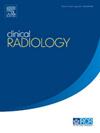Multimodality imaging findings in secondary dysmenorrhea
IF 2.1
3区 医学
Q2 RADIOLOGY, NUCLEAR MEDICINE & MEDICAL IMAGING
引用次数: 0
Abstract
Aim
Dysmenorrhea, characterised by painful menstruation, is a prevalent condition affecting up to 90% of menstruating women, with a significant impact on quality of life and daily functioning.
Primary dysmenorrhea occurs without identifiable pelvic pathology as a result of elevated prostaglandins and leukotrienes resulting in uterine contractility and crampy pelvic pain.
Secondary dysmenorrhea, on the other hand, arises from identifiable pelvic pathology most commonly endometriosis. Other aetiologies include uterine leiomyomas, adenomyosis, congenital Mullerian duct abnormalities and infection. Accurate diagnosis of pathology in secondary dysmenorrhea is vital for effective management, in order to address patient symptoms and improving outcomes.
Materials and Methods
This paper explores the multimodality imaging features associated with secondary dysmenorrhea, emphasising the importance of accurate diagnosis in guiding effective treatment strategies.
Results
Pelvic ultrasound, transabdominal and transvaginal, is typically the first-line imaging investigation due to its accessibility and effectiveness. Magnetic resonance imaging (MRI) offers improved soft tissue contrast and assessment of extrauterine anatomy, vital for resolving complex clinical challenges. Computed tomography has a more limited role but is extremely useful in the setting of suspected pelvic inflammatory disease.
Conclusion
We aim to explore the multimodality imaging findings in secondary dysmenorrhea, to aid accurate diagnosis, allowing for timely intervention and improving health outcomes and quality of life for women.
继发性痛经的多模态影像学表现
痛经的特点是月经疼痛,是一种影响高达90%的月经妇女的普遍疾病,对生活质量和日常功能有重大影响。原发性痛经发生时,前列腺素和白三烯升高,导致子宫收缩和痉挛性骨盆疼痛,无明显盆腔病理。另一方面,继发性痛经源于可识别的盆腔病理,最常见的是子宫内膜异位症。其他病因包括子宫平滑肌瘤、子宫腺肌症、先天性苗勒管异常和感染。准确的病理诊断在继发性痛经是至关重要的有效管理,以解决患者的症状和改善的结果。材料与方法本文探讨继发性痛经的多模态影像学特征,强调准确诊断对指导有效治疗策略的重要性。结果盆腔超声,经腹和经阴道,由于其可及性和有效性,是典型的第一线影像学检查。磁共振成像(MRI)提供了更好的软组织对比和子宫外解剖评估,对解决复杂的临床挑战至关重要。计算机断层扫描的作用有限,但在怀疑盆腔炎的情况下非常有用。结论探讨继发性痛经的多模态影像学表现,有助于准确诊断,及时干预,改善妇女的健康结局和生活质量。
本文章由计算机程序翻译,如有差异,请以英文原文为准。
求助全文
约1分钟内获得全文
求助全文
来源期刊

Clinical radiology
医学-核医学
CiteScore
4.70
自引率
3.80%
发文量
528
审稿时长
76 days
期刊介绍:
Clinical Radiology is published by Elsevier on behalf of The Royal College of Radiologists. Clinical Radiology is an International Journal bringing you original research, editorials and review articles on all aspects of diagnostic imaging, including:
• Computed tomography
• Magnetic resonance imaging
• Ultrasonography
• Digital radiology
• Interventional radiology
• Radiography
• Nuclear medicine
Papers on radiological protection, quality assurance, audit in radiology and matters relating to radiological training and education are also included. In addition, each issue contains correspondence, book reviews and notices of forthcoming events.
 求助内容:
求助内容: 应助结果提醒方式:
应助结果提醒方式:


